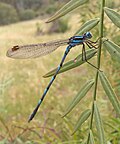Superregnum: Eukaryota
Cladus: Unikonta
Cladus: Opisthokonta
Cladus: Holozoa
Regnum: Animalia
Subregnum: Eumetazoa
Cladus: Bilateria
Cladus: Nephrozoa
Cladus: Protostomia
Cladus: Ecdysozoa
Cladus: Panarthropoda
Phylum: Arthropoda
Subphylum: Hexapoda
Classis: Insecta
Cladus: Dicondylia
Subclassis: Pterygota
Cladus: Metapterygota
Cladus: Odonatoptera
Cladus: Holodonata
Ordo: Odonata
Subordo: Zygoptera
Superfamilia: Lestoidea
Familia: Lestidae
Subfamilia: Sympecmatinae
Genus: Austrolestes
Species: A. aleison – A. analis – A. annulosus – A. aridus – A. cingulatus – A. colensonis – A. insularis – A. io – A. leda – A. minjerriba – A. psyche
Name
Austrolestes Tillyard, 1913
Type species
Lestes cingulatus Selys, by original designation
References
Tillyard, R.J. 1913(1912): On some new and rare Australian Agrionidae (Odonata). Proceedings of the Linnean Society of New South Wales, 37: 404–479, plates xliv–xlix. Biodiversity Heritage Library Internet Archive
| Male | Female | Scientific name | Common Name | Distribution |
|---|---|---|---|---|
| Austrolestes aleison Watson & Moulds, 1979 | Western ringtail | south-western Australia | ||
 |
 |
Austrolestes analis (Rambur, 1842) | Slender ringtail | South Australia, Victoria, New South Wales and Tasmania. |
 |
 |
Austrolestes annulosus (Selys, 1862) | Blue ringtail | Australia |
| Austrolestes aridus (Tillyard, 1908) | Inland ringtail | Australia | ||
 |
 |
Austrolestes cingulatus (Burmeister, 1839) | Metallic ringtail | Tasmania, Victoria and eastern New South Wales |
 |
 |
Austrolestes colensonis (White, 1846) | Blue damselfly, kekewai | New Zealand |
 |
Austrolestes insularis Tillyard, 1913 | Northern ringtail | northern Australia | |
 |
Austrolestes io (Selys, 1862) | Iota ringtail | south-western Australia and south-eastern Australia | |
 |
 |
Austrolestes leda (Selys, 1862) | Wandering ringtail | eastern Australia |
 |
Austrolestes minjerriba Watson, 1979 | Dune ringtail | northern New South Wales and southern Queensland | |
 |
 |
Austrolestes psyche (Hagen in Selys, 1862) | Cup ringtail | south-eastern Australia |
Etymology
The genus name Austrolestes is derived from the latin word auster meaning south wind, hence south; and the damselfly genus Lestes, which is from the Greek word λῃστής meaning a robber.[1][4] In 1913, Robin Tillyard described the genus Austrolestes as having characters similar to the very large genus Lestes, which, unlike Austrolestes, sit with their wings outspread.[1]
References
Tillyard, R.J. (1913). "On some new and rare Australian Agrionidae (Odonata)". Proceedings of the Linnean Society of New South Wales. 37 (1912): 404–479 [421]. doi:10.5962/bhl.part.22352 – via Biodiversity Heritage Library.
"Genus Austrolestes Tillyard, 1913". Australian Faunal Directory. Australian Biological Resources Study. 2012. Retrieved 4 April 2017.
Martin Schorr; Martin Lindeboom; Dennis Paulson. "World Odonata List". University of Puget Sound. Archived from the original on 28 August 2010. Retrieved 11 August 2010.
Endersby, I. (2012). "Watson and Theischinger: the etymology of the dragonfly (Insecta: Odonata) names which they published". Journal and Proceedings of the Royal Society of New South Wales. 145 (443 & 444): 34–53. ISSN 0035-9173 – via Biodiversity Heritage Library.
Günther Theischinger; John Hawking (2006). The Complete Field Guide to Dragonflies of Australia. CSIRO Publishing. ISBN 0-643-09073-8.
Annette Walker; et al. (2000). The Reed Handbook of Common New Zealand Insects. Raupo Publishing (NZ). ISBN 0-7900-0718-5.
Austrolestes is a genus of medium to large-sized damselflies in the family Lestidae.[2] Austrolestes damselflies sit with their wings folded completely back.[1] Males are usually bright blue and black, the females duller. Members of this genus are found in Australia, New Zealand and South Pacific islands.
Species
The genus Austrolestes includes the following species:[3]
Retrieved from "http://en.wikipedia.org/"
All text is available under the terms of the GNU Free Documentation License

